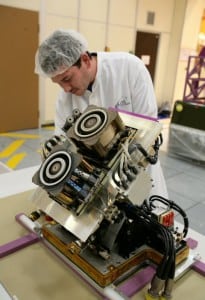Latest News

A Snecma electric propulsion system. Airbus has an agreement with Snecma for electric propulsion systems. Photo: Airbus Defence and Space
[Via Satellite 09-23-2014] Bolstered by recent new deals, Airbus Defence and Space has pulled ahead with two contract wins for all-electric satellites during 2014; a year where, so far, no other manufacturer has received any all-electric orders. Now in the process of building those satellites — Eutelsat 172b and SES 12 — the company expects the level of all-electric activity to continue to climb.
“What I was saying last year is that 25 percent of our Request for Proposals (RFPs) were asking for an option for electrical propulsion. Now we see more and more interest, and I would not exclude that in some few years from now this ratio of the RFPs asking for full electric propulsion will go up to 50 percent,” Eric Béranger, head of space systems and programs at Airbus Defence and Space, told Via Satellite.
Most, if not all, major satellite manufacturers, including Boeing, Thales Alenia Space, SSL and Lockheed Martin, have been pushing new fully electric designs but they have not managed to sign any contracts throughout 2014. In past years, Boeing in particular saw success in the fully electric realm with ABS 3A and Eutelsat 115 West B in 2012, followed by ABS 2A and Eutelsat 117 West B in 2013. These are all built on the low- to medium-power Boeing 702SP. Béranger, however, notes that Airbus’ recent orders, based on the Eurostar 3000 platform, have been for much higher power spacecraft.
“We see payloads that are growing and growing in terms of power. With SES 12 we are providing the highest power payload we have ever produced in Europe,” he said. “This is the first time ever that satellites are going to be produced and launched with full electric propulsion and with very high power payloads.”
But NSR Analyst Carolyn Belle cautions that the types of orders seen in 2014 should not yet be viewed as a pattern.
“Indeed the payload power of the most recently ordered all-electric satellites (and additionally, the new platforms that have been announced) surpasses that of the first ordered, but with the modest number of satellites ordered and platforms currently available this hardly constitutes a trend,” she said.
While fully electric propulsion systems offer a superior power-to-mass ratio, a downside is that they are more expensive than their traditional chemical counterparts. However, hybrid systems that employ a chemical thruster for orbit-raising followed by electric propulsion for station keeping have grown more rapidly and have been seen as a way to balance the pros and cons of each technology.
With a chemical propulsion system, a spacecraft can reach Geostationary Earth Orbit (GEO) in approximately five days, according to Béranger. When an electric system is employed for this job, it takes three to six months. The extra time spent in a transitional orbit delays the beginning of service, and increases exposure to the Van Allen radiation belts, another downside.
But an important pro to all-electric propulsion systems is that they are significantly lighter. With less mass, operators can pursue a variety of other options for design and launch.
“If you don’t change the mission, today the chemical propulsion system represents up to one half of the satellite mass,” said Béranger. “If you replace it totally by an electrical propulsion system, you cut it at least by two thirds.”
Airbus’ two most recent customers each chose different paths with their all-electric satellites. The 13kW triple-payload Eutelsat 172b satellite weighs in at 3,500 kg, meaning it can launch in the cost-effective lower-position on an Arianespace Ariane 5 launch vehicle. SES 12 weighs 5,300 kg and has a power of 19 kW. This heavy satellite will carry 76 transponders along with eight antennas, and is described by SES as fulfilling the role of two satellites in one.
Belle notes that the higher weight options with Airbus may have contributed more to the company’s recent wins.
“Smaller all-electric platforms experience a similar suite of drawbacks [as larger platforms], but are somewhat more constrained in terms of launch environment (best suited to dual launch with another all-electric satellite) than the larger and more powerful Airbus platform,” she said. “The timing for these orders is thus more critical.”
While Belle doesn’t consider it a trend in the industry yet, electric propulsion is gradually growing in popularity as operators push to get more out of their satellites. As operators warm to the idea, she adds the competition is likely to get fiercer.
“The two Airbus wins for electric platforms are targeted toward large and power hungry payloads that would have been difficult or even impossible to accommodate on a smaller electric platform (i.e. Boeing 702-SP). With Lockheed Martin now offering all-electric propulsion on their A2100, we could see more competition in the higher payload power market within which Airbus has been successful this year,” she said.
Get the latest Via Satellite news!
Subscribe Now